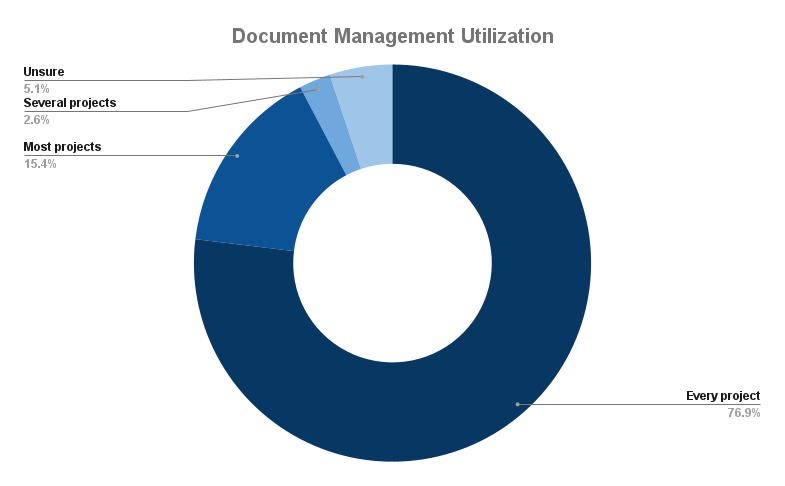Strong document management practices are crucial for an efficient construction project. However, in reality, keeping those lines of communication open between the field, office and all the other stakeholders involved can be tricky. In turn, a proliferation of document management solutions has emerged to address the construction industry's most pressing problems.
There also has been an increase in the adoption of software solutions addressing document management. BuiltWorlds' Benchmarking Research revealed the percentage of all respondents using a document management solution on every or most projects has grown from 80% in 2023 to 92% in 2024.
On a recent Analyst Call, BuiltWorlds hosted three companies looking to revolutionize document management and collaboration within the AEC space. Ronny Leyes, CEO of Kontrad; Luigi la Corte, CEO of Provision Software; and Dan Shaw, CEO of Legman, each discussed their solutions, as well as the current state of document management and its future during a Q&A session, excerpted below.
Responses edited for clarity.
As the co-founder and CEO of Provision Software, Luigi La Corte has spent a lot of time identifying what qualities and trends in the industry will make his startup standout.
"What we hear when talking to general and subcontractors is that workflow automation is very important to them,” La Corte said.
Big-name horizontal solutions like Sharepoint and Box, as well as some AEC specific solutions like Egnyte, already exist to meet the standard needs of a document management software, he added. However, people are wanting more from their document management solutions, namely workflow automation.
“My thesis and the Provision thesis is that automation on top of document management is going to make it a very attractive solution for people in construction," La Corte said.
Dan Shaw, co-founder and CEO of Legman, agreed.
“My co-founder, Mark [Dabler], and I spent a year doing customer interviews, customer discoveries, and actually Legman started as a ChatGPT wrap-around to proprietary data, which got us in the door in a lot of places, but no one wanted that,” Shaw said. “Everyone was asking for workflow automation.”
As what is expected from document management solutions has changed, technology on the forefront, like artificial intelligence, has emerged in solutions to meet this demand.
Ronny Leyes, CEO and founder of Kontrad, a platform dedicated to streamlining contract management in construction and engineering with AI tailored workflows, is in a prime position to notice the changing expectations.
"I think 5 years, or 10 years ago, when we looked at document management and collaboration systems, we were looking at systems handling documents as a unit, which means you would have an Excel sheet or PDF and sharing it meant being able to share that document with 1000 people at the same time,” Leyes explained. “Now what we are looking at are solutions that are able to break the document down into pieces, look into the document, extract content, and build data from that document and to help understand the content."
As technology has progressed, he added, customers want those extra capabilities from their document management solution.
Shaw introduced the idea of artificial intelligence in document management as a solution to deal with risk management. Construction workers are often overworked and, Shaw pointed out, “AI and machine learning are providing another set of eyes for people who are doing a lot of work.”
Using artificial intelligence as more of a tool to help ease the burden on construction workers distinguishes the construction industry from the financial sector in Shaw's eyes.
“I don't think the construction industry views AI and ML in the same way as the financial industry does in the sense of the ability to reduce headcount. I think the construction industry views it as we are now able to do more, do more better, and deliver projects more profitable," he said.
La Corte also had an interesting take on where AI and machine learning stand within the construction industry. While many often think of the construction industry as especially hesitant to embrace this change and new technology, La Corte has observed a willingness to try in the face of concerns around long-term efficacy. While there is an expectation that this technology is sometimes wrong, he said, corporations’ willingness to give new technologies a chance has accelerated the sales cycle.
“We are seeing people make decisions in the mid-five figures fairly quickly and that is really encouraging, a great sign for new startups to get in the market, try and sell some stuff, and ultimately get some traction. That's what venture capital wants to invest in, too, which creates this beautiful positive feedback loop for more startups," La Corte said.
"People changing their view on AI—i.e., 'I want to try it'—is going to do wonders for the industry. I am really excited for what the future holds."
BuiltWorlds Benchmarking Research

BuiltWorlds research showed 92% of respondents used a document management solution on every or most projects. While 5% were unsure about the implementation of their organization’s document management solutions, no respondents indicated not using a document management solution. This made document management solutions the most implemented technology specialty area addressed in the Annual Project Software Benchmarking Report.
BuiltWorlds noticed similar trends as the speakers did from our Benchmarking Research. Of top use cases for document management solutions, 65% of respondents identified "streamline review and approval workflows" and 43% said "use automation tools" are key use cases for them. Solutions that go beyond just document management, including automation, are an important feature that contractors are looking for. Overall, when it comes to adoption and satisfaction with document management solutions, a majority of respondents are utilizing a solution often, and indicate that their solution justifies the cost to some extent.



Discussion
Be the first to leave a comment.
You must be a member of the BuiltWorlds community to join the discussion.